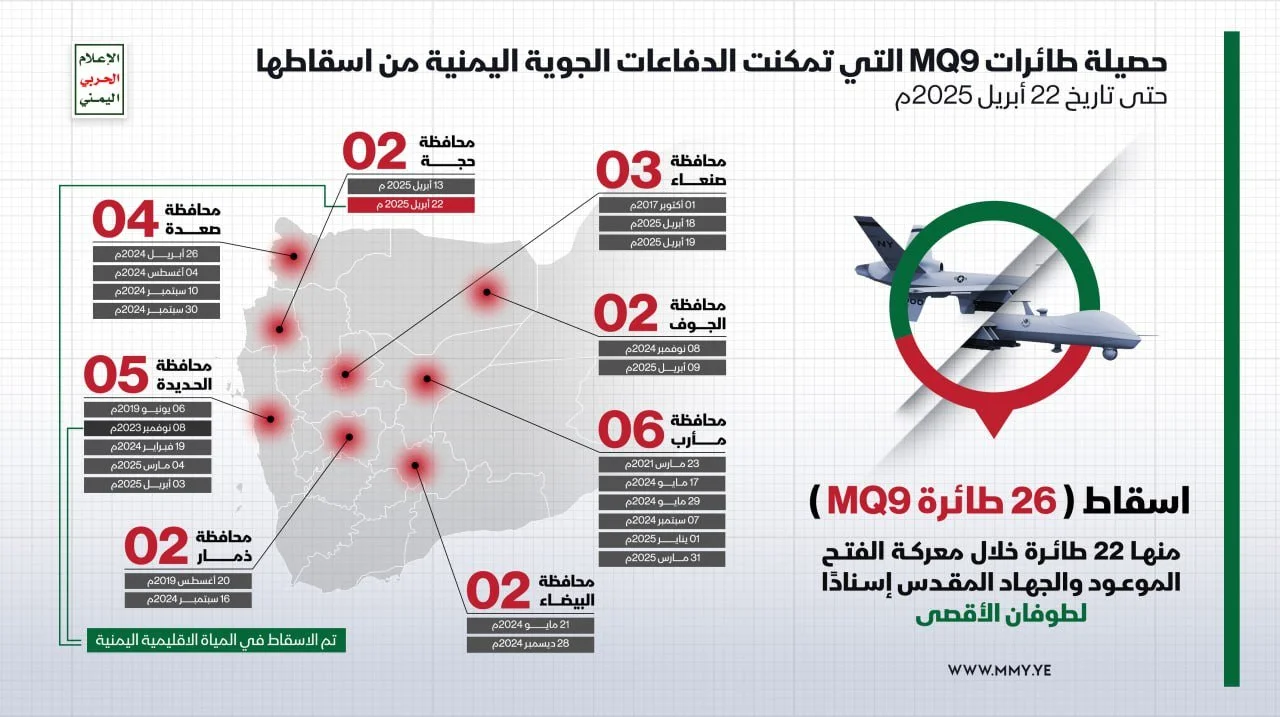Houthis Claim 22nd MQ-9 Drone Downed, Share Image Listing Each Kill by Date and Location
Executive Summary
The Houthis claimed on April 22, 2025, to have downed their 22nd U.S.-made MQ-9 Reaper drone, this time off the coast of Hajjah province, Yemen, using a domestically produced surface-to-air missile. The shootdown is the seventh in April alone and part of a larger campaign dubbed the “Promised Conquest and Sacred Jihad.” Alongside this claim, the Houthis released a graphic listing the dates and locations of each claimed MQ-9 shootdown. The attack was coupled with strikes against U.S. aircraft carriers in the Red Sea and Arabian Sea, and framed as a continued show of solidarity with Gaza. The move is part of an ongoing military and propaganda campaign that seeks to bolster Houthi domestic legitimacy, impair U.S. surveillance capabilities, and signal regional defiance against Western forces.
Analysis
Brigadier General Yahya Saree, spokesperson for the Yemeni Armed Forces (YAF), stated the drone was engaged while conducting “hostile missions” over Yemeni airspace. This incident brings the total number of MQ-9 drones the Houthis claim to have shot down to 22, with a notable uptick in April.
The MQ-9 drone shootdowns are a key component of a broader strategic posture. The Houthis aim to degrade U.S. ISR (intelligence, surveillance, reconnaissance) capabilities, which underpin airstrike targeting efforts under Operation Poseidon Archer. Tactically, these attacks reduce the effectiveness of U.S. air campaigns. Strategically and symbolically, each shootdown serves as propaganda—offering visual “proof” of Houthi military efficacy and resistance against U.S. and Israeli power.
Reports from the Atlantic Council warn that if Houthi claims are accurate, this pace of drone losses—nearly two per month—poses a costly threat to U.S. aerial dominance, given each MQ-9 costs roughly $30 million. The risk isn’t only in cost or combat degradation. Downed drones also present intelligence vulnerabilities, as adversaries such as Iran, Russia, and China could exploit captured tech for reverse engineering or countermeasure development.
Houthi missile capabilities appear to rely on a blend of smuggled Iranian systems and modified prewar Yemeni army stock. The missiles used, including variants of Iran’s Sayyad and Barq families, have proven sufficient against high-altitude targets like the MQ-9.
Meanwhile, U.S. airstrikes continue across Yemen, targeting launch sites and suspected leadership in Sanaa, Saada, Marib, and Hodeidah. The Trump administration has intensified its campaign since mid-March, claiming it aims to “rapidly destroy” Houthi capabilities. Houthi retaliation remains unrelenting, targeting U.S. ships and Israel-linked assets with cruise missiles and drones.
The Houthi MQ-9 kill-list graphic, released on social media, reinforces their regional messaging and narrative leadership within the Axis of Resistance. While many claims remain unverified by U.S. officials, the pattern of persistent engagement, increasing tactical proficiency, and deepening ties to Iran-backed actors point to a new phase in the Houthi war effort—one that now reaches into U.S. strategic aviation dominance.


